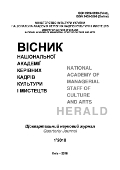ART MUSEUM WITH THE INFLUENCE OF PERSIAN MINIATURE IN THE ARCHITECTURAL SPACE
DOI:
https://doi.org/10.32461/2226-3209.1.2018.177215Анотація
Abstract. The Iranian artist's long-lasting attempt has been towards idealism.An Iranian painter has always been inclined to portray the world as it should, not to portray her own image of the world.In such a way that the universe reflected in the form of the transformed artist’s will and reflected in the light of the harmonious laws.The reality is that the major schools of painting was based on Persian literature and developed elsewhere in the region.Specific and poetic visualization, iconography is an achievement of the Islamic art of Iran. The Iranians entered some kind of beauty into imagination into the architectural space and created decorative shapes which affected the nature of architecture.It aims to create a fantastic space and a floating world of imagination and embodiment of unity by
applying all the ideals and elements of painting in space.This research deals with qualitative study of the art of painting and interpretation features.a framework based on three cognitive, beautiful and historical aspects, has been designed to analyze the methods of understanding the art of painting and architectureand identifies the weakness and strength of each of them and finally, a way to understand the architectural space in the Iranian paintings based on four pillars are cleared which include 1-Scrolling 2- scan the history of typology and cognitive symbols 3- Phenomenological and
symbolic scans 4-Intuitive reflection (Veridical). Meanings may either endorse one another or abandon one another.From the results of this research, it is possible to present a new and well-known aesthetic solution in painting and architecture.
Key words: Art, Painting, Architectural space
Посилання
Baudrillard, Jean, Jean Baudrillard and the limits of Critical Media, Educational Theory, 13 october, 2016
Chomsky, N, (1986), Knowledge of Language: Its Nature, Origin and Use. N.Y.Praeger
Chomsky, N, (1965), Aspects of the Thoery of Syntax, Cambridge, Mass:M.I.T.Press
Dirgantoro, Wuldandani, (2014), Asian languages and Studies program, Defining Experiences: Feminisms and
Contemporary Art in Indonesia, University of Tasmina.
Kafle, Narayan Prasad, (2011), Hermeneutic phenomenological research method simplified, Bodhi: An Interdisciplinary Journal, ISSN: 2091- 047
Merleau-Ponty, M. (1968). The visible and the invisible. Evanston: Northwestern University Press
Merleau-Ponty, M. (2002). Phenomenology of perception. London: Routledge & Kegan Paul.
Panofsky, Erwin. (1955), Meaning in the Visual Arts, New York: Dobleday Anchor Books.
Scalvini, M.L. L’architettura Come Semiotica Connotativa; Bompiani: Milano, Italy, 1975
##submission.downloads##
Номер
Розділ
Ліцензія
Автори, які публікуються у цьому журналі, погоджуються з наступними умовами:
1. Автори залишають за собою право на авторство своєї роботи та передають журналу право першої публікації цієї роботи на умовах ліцензії Creative Commons Attribution License International CC-BY, котра дозволяє іншим особам вільно розповсюджувати опубліковану роботу з обов'язковим посиланням на авторів оригінальної роботи та першу публікацію роботи у цьому журналі.
2. Автори мають право укладати самостійні додаткові угоди щодо неексклюзивного розповсюдження роботи у тому вигляді, в якому вона була опублікована цим журналом (наприклад, розміщувати роботу в електронному сховищі установи або публікувати у складі монографії), за умови збереження посилання на першу публікацію роботи у цьому журналі.
3.Політика журналу дозволяє і заохочує розміщення авторами в мережі Інтернет (наприклад, у сховищах установ або на особистих веб-сайтах) рукопису роботи, як до подання цього рукопису до редакції, так і під час його редакційного опрацювання, оскільки це сприяє виникненню продуктивної наукової дискусії та позитивно позначається на оперативності та динаміці цитування опублікованої роботи.

